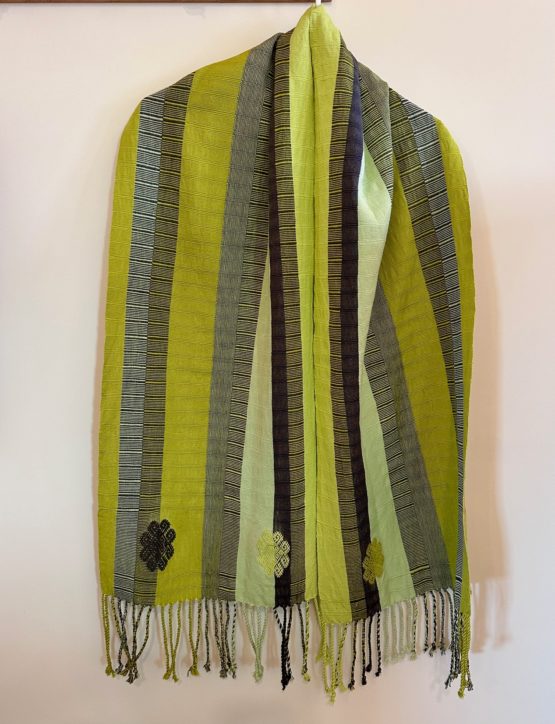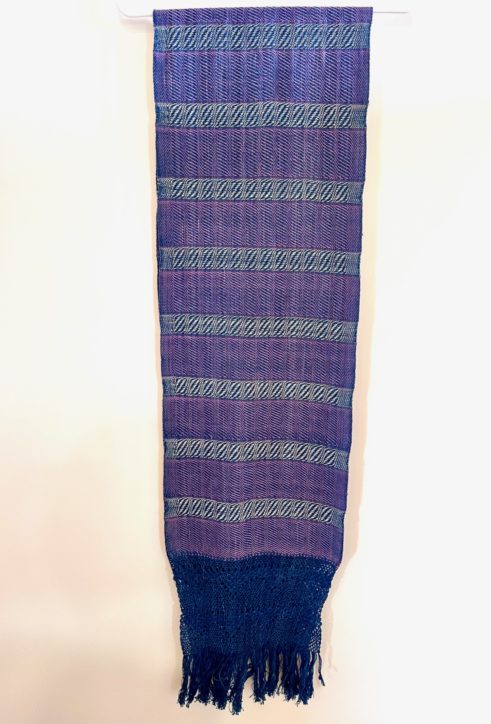We’ve been traveling on Oaxaca’s Costa Chica for the past four days. This is the stretch of territory that starts at Puerto Escondido on the Pacific Ocean and goes north to Acapulco along Mexico’s Highway 200.

Women of the Jini Nuu Cooperative, San Juan Colorado, wear posahuanco skirts
A highlight of our 12-day Oaxaca Textile Study Tour that started in the central valleys of Oaxaca, was a visit to San Juan Colorado, a remote Mixtec village at the end of the road in the fold of a mountain above Oaxaca’s coast.

Taking the seeds out of the coyuchi native brown cotton
In this weaving village, women work with three varieties of native cotton: coyuchi, natural and green. They use natural dyes from tree bark, flowers, indigo and cochineal.

Native Oaxaca pre-Hispanic cotton, coyuchi brown and green
Interested in going in 2019? Send me an email.

Our breakfast at the cooperative–sopes, eggs with hierba santa
On occasion, they will insert thread dyed with purple that comes from the caracol púrpura snail, endangered and harvested from ocean outcroppings of rock. Legally, only a few indigenous men are licensed to harvest the snail. They gently squeeze the ink onto cotton or silk and return the live snail to its home. Poachers threaten its existence.

Zenobia Zenaida beats cotton to soften and lengthen the fibers
They weave geometric designs on back-strap looms using a supplementary weft technique of counting and adding threads to the cloth. Their work is prized and many whom we met are featured on posters that hang on the walls of the Museo Textil de Oaxaca education department.

Cloth woven on back strap loom with supplemental weft
Cotton is prepared by first washing it, drying it and removing the seeds. A woven palm leaf mat, called a petate, is draped over a roll of corn husks that is tied with a long palm frond. Everyone here knows how to clean, wash and beat cotton. Not everyone spins using the drop spindle malacate. It is a special skill.

Detail of weft thread counting to add supplemental weft design
Seventy-five year old Zenobia Zenaida Lorenzo is the cotton beating expert her cotton is the softest and easiest to spin, all the women agree. Beating the cotton achieves the same result as using a carder for wool.

Dale tries her hand at cotton beating–force and rhythm
Work is differentiated by gender. The men grow and harvest cotton, planting in August and harvesting in December. They make the wood tools and parts for the back strap loom. Women weave in between cooking, cleaning and caring for children.

Spinning and cleaning wool in San Juan Colorado
Identity is interwoven with cloth here. Women imbed ancient symbols of fertility and images of the natural world into the cloth. Each adapts a uniform design to make her own fabric unique.

Welcome to the Jini Nuu Cooperative of 300 women, existing since1990
Traditional traje, or dress, consisted of a back strap loomed skirt woven with cotton dyed with cochineal (red), indigo (blue), and purple (caracol purpura). The weather is hot and steamy.

Corn husk roll, cover it with a petate for beating cotton

Marsha tries the back strap loom, leans back against the strap, comfortable
This is a traditional topless culture. Today, in the regional market, we see a few older women covered with gauze transparent shawls, doubled and draped over their bosom.

Now, it’s time to shop. Denise has her hand on a huipil with all natural dyes
Remote villages throughout Mexico have been able to keep their traditions and identity because of their isolation from the contemporary world. Now, very few places are inaccessible and the pressure to conform with western clothing is intense.

I get in on it, too, with help from Zenobia Zenaida
Like this:
Like Loading...










































Beating Wild Cotton on the Oaxaca Costa Chica
We’ve been traveling on Oaxaca’s Costa Chica for the past four days. This is the stretch of territory that starts at Puerto Escondido on the Pacific Ocean and goes north to Acapulco along Mexico’s Highway 200.
Women of the Jini Nuu Cooperative, San Juan Colorado, wear posahuanco skirts
A highlight of our 12-day Oaxaca Textile Study Tour that started in the central valleys of Oaxaca, was a visit to San Juan Colorado, a remote Mixtec village at the end of the road in the fold of a mountain above Oaxaca’s coast.
Taking the seeds out of the coyuchi native brown cotton
In this weaving village, women work with three varieties of native cotton: coyuchi, natural and green. They use natural dyes from tree bark, flowers, indigo and cochineal.
Native Oaxaca pre-Hispanic cotton, coyuchi brown and green
Interested in going in 2019? Send me an email.
Our breakfast at the cooperative–sopes, eggs with hierba santa
On occasion, they will insert thread dyed with purple that comes from the caracol púrpura snail, endangered and harvested from ocean outcroppings of rock. Legally, only a few indigenous men are licensed to harvest the snail. They gently squeeze the ink onto cotton or silk and return the live snail to its home. Poachers threaten its existence.
Zenobia Zenaida beats cotton to soften and lengthen the fibers
They weave geometric designs on back-strap looms using a supplementary weft technique of counting and adding threads to the cloth. Their work is prized and many whom we met are featured on posters that hang on the walls of the Museo Textil de Oaxaca education department.
Cloth woven on back strap loom with supplemental weft
Cotton is prepared by first washing it, drying it and removing the seeds. A woven palm leaf mat, called a petate, is draped over a roll of corn husks that is tied with a long palm frond. Everyone here knows how to clean, wash and beat cotton. Not everyone spins using the drop spindle malacate. It is a special skill.
Detail of weft thread counting to add supplemental weft design
Seventy-five year old Zenobia Zenaida Lorenzo is the cotton beating expert her cotton is the softest and easiest to spin, all the women agree. Beating the cotton achieves the same result as using a carder for wool.
Dale tries her hand at cotton beating–force and rhythm
Work is differentiated by gender. The men grow and harvest cotton, planting in August and harvesting in December. They make the wood tools and parts for the back strap loom. Women weave in between cooking, cleaning and caring for children.
Spinning and cleaning wool in San Juan Colorado
Identity is interwoven with cloth here. Women imbed ancient symbols of fertility and images of the natural world into the cloth. Each adapts a uniform design to make her own fabric unique.
Welcome to the Jini Nuu Cooperative of 300 women, existing since1990
Traditional traje, or dress, consisted of a back strap loomed skirt woven with cotton dyed with cochineal (red), indigo (blue), and purple (caracol purpura). The weather is hot and steamy.
Corn husk roll, cover it with a petate for beating cotton
Marsha tries the back strap loom, leans back against the strap, comfortable
This is a traditional topless culture. Today, in the regional market, we see a few older women covered with gauze transparent shawls, doubled and draped over their bosom.
Now, it’s time to shop. Denise has her hand on a huipil with all natural dyes
Remote villages throughout Mexico have been able to keep their traditions and identity because of their isolation from the contemporary world. Now, very few places are inaccessible and the pressure to conform with western clothing is intense.
I get in on it, too, with help from Zenobia Zenaida
Like this:
8 Comments
Posted in Cultural Commentary, Oaxaca Mexico art and culture, Textiles, Tapestries & Weaving, Travel & Tourism, Workshops and Retreats
Tagged back strap loom, coyuchi, fiber, green cotton, Mexico, Mixtec weaving, native cotton, Oaxaca, San Juan Colorado, textile